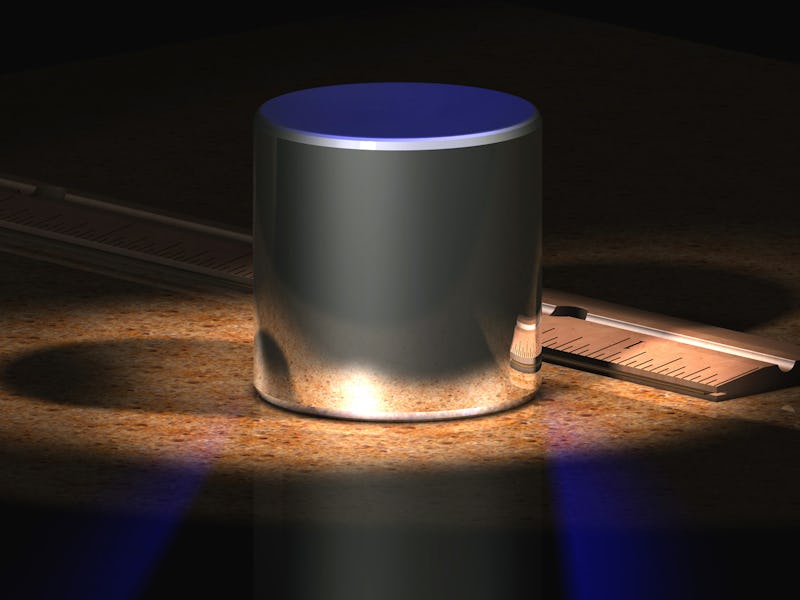RIP the Kilogram, Which Will Never Be the Same Again
International standards shouldn't be based on a lump of metal in Paris.

Most people know how much a pound weighs — 16 ounces. The worldly among us may know that a kilogram is 2.2 pounds — or 1,000 grams. But do we really know what these numbers mean? Agreeing on units of measurement is a lot more complicated than it might seem, and the way humans agree on weights around the world is about to completely change.
For over a century, the world standard for the kilogram has been the International Prototype of the Kilogram, a cylinder made of platinum and iridium that’s stored at the Bureau International des Poids et Mesures (International Bureau of Weights and Measures) in France. The BIPM is an international organization that helps standardize international science and trade by establishing standards for measurements that we can all agree upon. This is why the BIPM has the IPK: Without this heavy little cylinder, the world would not have a standard kilogram to determine what a kilogram weighs. Copies of the IPK (sometimes affectionately referred to as “Le Grand K”) have been distributed around the world so member countries can maintain the standard, and every 40 years the IPK is measured to make sure it’s still a kilogram. Recent measurements have shown, though, that the masses of these Grand Ks are diverging, which could spell chaos for trade, science, and potentially such sensitive fields as rocketry, in which calculations must be precise.
This system may sound bizarre and archaic, but there’s a good reason why the world has used this reference weight for so many years: It’s really hard to figure out what a kilogram is any other way. Here’s why.
Whereas we may think different units of measurement are their own natural laws, defined in reference to each other — for instance, a day is 24 hours, and an hour is 60 minutes, and a minute is 60 seconds — the truth is that units of measurement have historically been defined in terms of some concrete phenomenon in the world. In metrology, the study of measurement, these concrete phenomena are known as artifacts.
As aerospace engineer Max Fagin outlined in a tweet thread on Thursday, scientists have come a long way over the years when it comes to figuring out how to move beyond artifacts so they can measure stuff without having to put it next to other stuff. For instance, a second used to be measured as a 1/31556925.9747 of the time it takes for the Earth to go around the sun. Now it’s defined as the amount of time it takes for an electron in a cesium-133 atom to oscillate 9,192,631,770 times. This may sound unnecessarily specific and frankly bizarre, but by defining a unit of measurement in terms of an atom’s behavior, scientists can say with a fair degree of certainty that a second is a second, no matter where you are in the universe — and no matter whether you have a stopwatch.
In short, scientists have moved the standard point of reference for measurements off of human-made objects and onto universal constants. All except for the kilogram.
The second, like the kilogram, meter, and four other units, make up the Systéme International units. These are the most basic units of measurements that all others are based on. Nowadays, most of the SI units can be determined without some kind of artifact, but measuring a kilogram is much more difficult because it requires complex calculations that are made more complicated by gravity. After all, while we often think of mass and weight as the same, they’re not. Mass, as measured in kilograms, is how much matter is in an object. But that’s how scientists plan to make the IPK obsolete.
This is where the Kibble Balance comes in to save us. This device, which is under development by multiple labs. The National Institute of Standards and Technology in the US, and the National Physical Laboratory in England are both working on this device, which will hopefully redefine the kilogram in terms of Planck’s constant, a number that’s central to our understanding of quantum mechanics. In short, this device doesn’t determine mass by measuring weight, but by measuring the electromagnetic force between two plates. Oh, and it’s all done in a vacuum.
The Kibble Balance, to put it simply, should be able to measure the mass of an object — the IPK, for instance — in terms of electrical power. To get all the math involved, check out the video below. For anyone who’s not into the nitty-gritty of physics, though, suffice it to say that the Kibble Balance should help scientists redefine the kilogram.
“One key reason for doing this work is to provide international security,” Ian Robinson, head of the National Physical Laboratory’s engineering measurement division, told Luxembourg news outlet Delano. “If the Pavillon de Breteuil” — where the IPK is stored — “burned down tomorrow and the kilogram in its vaults melted, we would have no reference left for the world’s metric weights system. There would be chaos. The current definition of the kilogram is the weight of that cylinder in Paris, after all.”
And that’s just not good enough for international science.